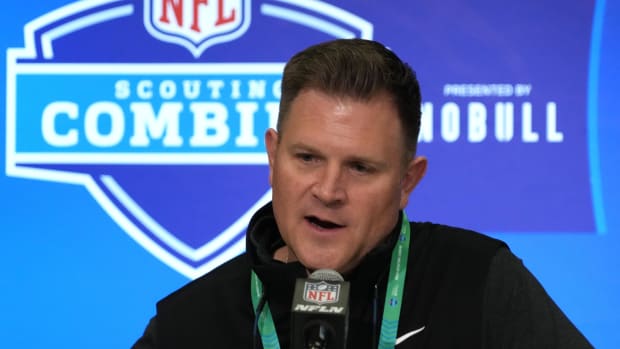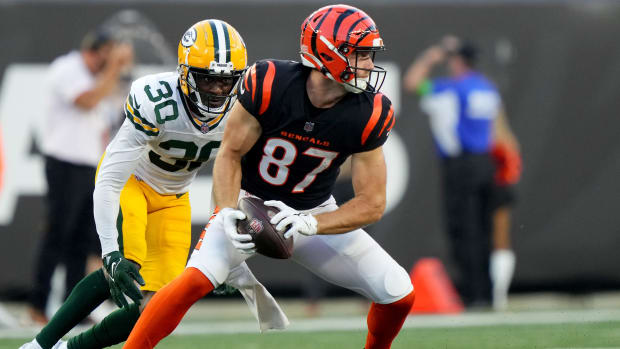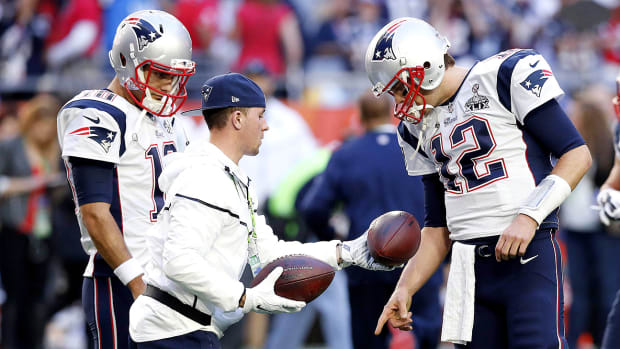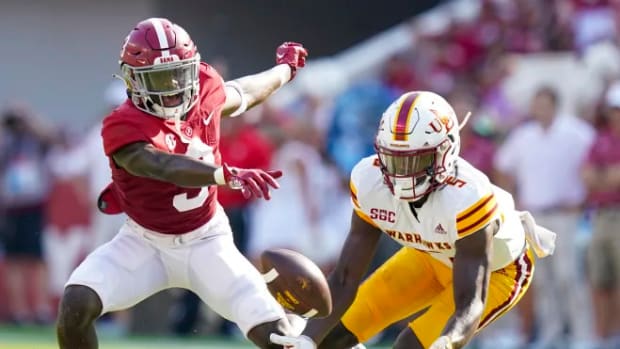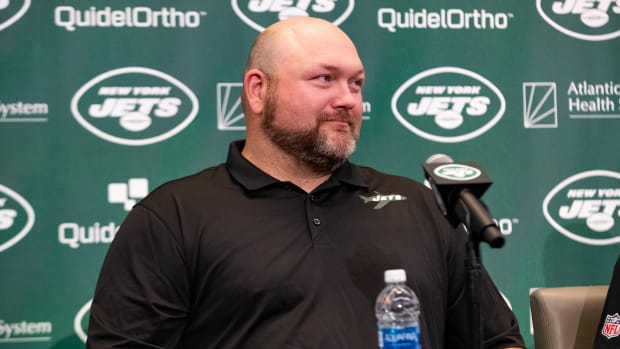How the NFL Would Accommodate Spring College Games and a Delayed Draft Season
2020 has been a wild year already in the football world. Would you believe 2021 could be … well, maybe not just as wild, but close?
Imagine this—the Big Ten launches a season Jan. 1, playing on Thursday and Friday nights during the first two rounds of the NFL playoffs, and on Saturdays otherwise. And they do it in some combination of the five indoor football stadiums (Syracuse, Detroit, Indianapolis, Minneapolis, St. Louis) within shouting distance of the league’s footprint. Meanwhile, on the more temperate West Coast, the Pac-12 launches with a similar plan.
In this scenario, an eight-game season, with a bye, could be wrapped up by the end of February, with some semblance of a postseason completed by mid-March.
Maybe the ACC, SEC and Big 12 join in, maybe they don’t. Either way, this shakes up the ’21 calendar for the NFL significantly. And if you want to know how the NFL would react to this, I’ve got news for you—these sorts of concepts aren’t just landing on their radar now.
I’m told these are ideas that have been discussed by college coaches already and, notably, NFL teams would be willing to help. The Lions, for one, were approached by a Big Ten school all the way back in the spring about using Ford Field in this way. NFL teams also have discussed what it would take to move the combine and the draft back a month (potentially having the combine in early April and draft in late May) to accommodate the college game.
Are there a lot of moving parts here? Sure. But there’s also reason for people involved to be motivated to get it done. For the Big Ten and Pac-12, this would be a shot—by playing a winter season rather than a spring season—to give their players the chance to play without totally firebombing their 2021 season, and maybe even create an option for other conferences to delay their seasons. For the NFL, it would mitigate what will certainly be a messy, messy situation for its ’21 draft class, in getting most top prospects on the field.
And then, there’s something simpler at play. The NFL needs college football to remain the force that it is for a multitude of reasons. Having all five power conferences play, in whatever form, between now and whenever the draft happens is, without question, the best way to get there.
Now, I don’t know exactly how likely this is to happen. But I do believe the idea—with some colleges playing in the winter, leading into a delayed draft season—is something you’re going to hear more about in coming weeks.
***
The GamePlan’s here, and teams are practicing, and we’re now exactly one month away from the first Sunday of NFL action. Here’s what we have for you this week …
• A ranking of underrated camp story lines.
• The one position group that could really struggle with the COVID-19 circumstances.
• A lawsuit you might want to pay attention to.
But we’re starting with the mess that’s become of the college season, and how the NFL and college football will be working together to get through it.
***
So here’s the potential calendar, if you want to lay it all the way out.
Jan. 1-2: Big Ten/Pac-12 opening weekend.
Jan. 7-8/Jan. 14-15: Big Ten/Pac-12 Thursday/Friday night games.
Jan. 23: Big Ten/Pac-12 schedule goes back to Saturday.
Feb. 6-7: Bye weekend for Super Bowl.
Feb. 28: Final week of regular season.
March 6: Big Ten title game.
March 13-20: Rose Bowl OR National playoff.
Late April: NFL combine.
Late May: NFL Draft.
Roger Goodell can, unilaterally, move the draft as far back as June 2, per the CBA. The hurdle they’d have to overcome is logistical—making sure they can stage the draft (and clear hotel rooms, public parks, etc.) a month after they’d planned to. I wouldn’t suggest that would be easy, but, remember, we have no clue if fans will even be able to attend, and this year’s draft is in Cleveland, a city full of Big Ten alums in the heart of Big Ten country.
That would make one more party motivated to get this done.
And that would make what promises to be the zaniest draft cycle in NFL history even crazier. In the lead up to last April’s draft, we all got fond of saying how there’d never be a year quite like that one ever again. The recent uptick in COVID-19 cases nationwide, and subsequent impact on the college season, looks like it’s going to prove that thought dead wrong.
“You’ll be drafting guys in May 2021 that haven’t buckled a chinstrap since December 2019,” said one AFC college scouting director. “And think about it—so many guys were drafted this year due, 90%, to what they did their junior or senior year. Without that, we’ll have guys overdrafted, underdrafted. This year, everyone kept saying that you’re gonna look back at that draft, and that’s going to be the draft that you’ll study.
“Well, last year, we got every piece of information as normal until the combine. We just didn’t get that last part. This year, every piece of information is going to be touched by COVID. You’re gonna have guys drafted in the second round that stink, and guys drafted in the seventh round that are studs. And the importance of your scouts? They’ve never been more important.”
No one needs to wait to see if the Big Ten and Pac-12 can pull off the above to figure that out. The wheels are already turning toward a really unusual fall. In a number of different ways.
The Zoom calls. All the major programs are staging them now—Auburn held one on Wednesday—to try and help college scouts make up what they’re missing. Rules are still being formulated on whether or not those guys will be able to visit schools at all, but teams know for sure it won’t be business as usual.
Usually, at this time of year, college scouts would be hitting the road and visiting fall camps to lay the foundation for fall, seeing their sources on campus, getting body types in practice, and figuring out which players should be on their radar for the months ahead. In place of that, the Zoom calls at least have given teams a chance to gather baseline information on prospects.
As you’d expect, schools are handling these in a variety of ways. Some of the bigger programs are doing 3-4-hour sessions, or a series of shorter sessions, and cycling their NFL liaisons, strength coaches, academic advisors and trainers through to disseminate information. Smaller schools that have only a couple standouts have brought position coaches on, too, to help on those specific guys—Western Michigan, for example, had their receivers and linebackers coaches on to talk Dwayne Eskridge and Treshaun Howard.
“There’s a reason we go to the school,” said an AFC exec. “You want to watch a player practice, his tempo, his mannerisms, how he competes and works, and see him do things you’d expect him to do when gets to your team. And being there enables you to reach out to contacts, and spend time with your network of people. So you’re not getting that exposure. But the Zoom calls have been effective as an initial background rundown of the players.”
And, really, it just gives teams an idea of what they’ll need to dig into.
Being dialed in counts. One team I spoke with on Wednesday is already working on getting younger scouts more dialed in—and asking older, more connected guys in the building to call schools and vouch for less-experienced counterparts. Normally, this time of year is great for those younger guys to go meet the grad assistant, trainer or position coach he’ll need in the months to come and establish relationships with them. Absent that face time, this sort of blind-date approach is one way to make up for what’s lost.
So as we’ve mentioned in a few places the last few weeks, this is a year that a scout’s Rolodex is gold. If the coordinator for a key prospect only has time to call, say, four people back, having one of the four scouts he calls back could prove a major advantage in 2020, even more so than it normally is.
“I’m on a Zoom with 20 or 25 other scouts, and the schools are doing a good job with the Zooms, but they’re not giving you all the info you need,” said the AFC scouting director. “And I don’t blame them. I’d never say, ‘He’s an a------,’ or ‘He doesn’t know football,’ on a Zoom with a bunch of people on there I don’t know. I wouldn’t put that on a Zoom. It’s hard to get that info. But if you have good scouts, they can.”
Another veteran scout reiterated, “When the guy on that Zoom makes three calls afterwards, this year, you gotta be one of those three calls he makes.”
Some guessing might be involved. Joe Burrow’s tweet on Sunday—“If this happened a year ago I may be looking for a job right now”—rang true with a lot of players. Burrow’s LSU teammate Clyde Edwards-Helaire rushed for 658 yards as a backup to Nick Brosette in 2018. Arizona State WR Brandon Aiyuk caught 33 passes for 474 yards and three scores in 2018, playing behind now-Patriot WR N’Keal Harry.
It’s safe to say without a 2019 season, those guys aren’t sniffing the first round. With one, Burrow wound up going first overall, Aiyuk 25th to the Niners, and Edwards-Helaire 32nd to the Chiefs. So maybe there’s a tackle at Georgia who was stuck behind Andrew Thomas and Isaiah Wilson, or a corner at Ohio State who was behind Jeff Okudah and Damon Arnette who was going to pull an Aiyuk—and now might or might not have the opportunity to.
“There are a lot of them that just haven’t gotten a chance at an Alabama or a Clemson, that have to bide their time to play,” said an NFC exec. “Or guys that have been injured, where there’s just not a lot of tape on them. The Purdue receiver [Rondale Moore] is like that. He’s a hard guy to evaluate, with his injury history. Those are the types that’ll be tough. And some quarterbacks like Burrow or [Dwayne] Haskins, they’re the ones that made the jump, they needed those throws. … That’s why if I’m a quarterback, I might not come out.”
If you need a good example to follow, here’s one: FAU RB B.J. Emmons. A former five-star recruit, Emmons got a little lost in a crowded backfield at Alabama, transferred to junior college, then landed at FAU. Then, in last year’s opener at Ohio State, he broke his ankle. He came back late in the season and, suddenly, all the talent that was there in the first place started to flash. Scouts were excited to see him play in 2020 as a result.
Now? Well, if FAU’s season gets canceled, he could enter the draft having logged just 86 carries at the Division I level.
“He showed some really good stuff, and he’s talented now,” said another scout. “This really could hurt a guy like that.”
The All-Star games. The Senior Bowl will be conducting a call with all 32 teams on Thursday to start to work on plans for its 2021 game, without a clue on whether or not it’ll be feasible to gather guys from different parts of the country in the early part of next year. They’ll brainstorm ideas and try to figure out how the event can serve the players and teams best in this most unusual year, while discussing contingencies for the uncertainty.
The game, I’m told, could be moved if there are major changes to the structure of the college season—like the Big Ten and Pac-12 moving their seasons to winter. And it could take on a different look, too, if COVID restrictions force that.
This much, I know: That game, and the other All-Star games, will take on added importance. Scouts need to eyeball prospects, and see who’s gotten bigger, faster and stronger, and the Mobile, Ala. event—and its counterparts—would give them their first chance to do that with players coming from conferences that don’t play in 2020.
But, again, the Senior Bowl folks want the number of guys that don’t play ahead of the 2021 draft to be as low as possible. So if that means moving their event so kids don’t have to choose between playing in the Senior Bowl and playing against Iowa or Oregon, then it’ll almost certainly be moved.
***
There are some pieces to the scouting process that will be, of course, irreplaceable. And so teams won’t try.
No one’s expecting colleges to let NFL scouts into their football programs’ facilities this fall, given the circumstances, but if evaluators were permitted on the sidelines at practice, there’d be a lot of value in that, in simply getting body types. (One exec raised the examples of Vic Beasley and Brian Burns in recent years, guys who played in the 220s as collegiate pass-rushers, and bulked for the pre-draft process, to illustrate why that’d be important.)
If scouts are allowed at games, that would be another good point of reference—one scouting chief told me that if that happens, and the two teams are solid, he’d tell his scouts to spend one half behind one bench, and the other behind the other bench, to capture the stuff that won’t show up on tape (how a prospect carries himself, interacts with teammates, leads, etc.) but can be meaningful in the final analysis.
All this shows how every point of reference—and every resulting piece of information—is going to matter for these guys over the next eight months.
So if the Big Ten and Pac-12 can figure out a way to play? It’d totally make sense that the NFL would be trying to help them every step of the way. And based on what I know, I believe the NFL absolutely will.
***
POWER RANKINGS
Camp’s here! And that means, normally, I’d be introducing you to some of the fresh storylines looming over the 2020 season. That’s not possible from the ground this year. So we’ll do this from 30,000 feet here (and mine these in the coming weeks)—here are my top-five underrated stories looming over the 2020 season (FYI: Nothing COVID-19-related is under-the-radar at this point).
1) The Saints’ big shot. New Orleans’s roster is loaded. There’s not a more complete team in football. But the bills are coming due on the great draft classes that provided the foundation for that. Consider this: Marshon Lattimore, Alvin Kamara, Sheldon Rankins and Ryan Ramczyk are all eligible for second contracts but remain on rookie deals. So the construct of the team could change soon, and that’s before you consider that Drew Brees turns 42 in January. Which means the time for this group almost has to be now.
2) Prove-it time for the 2018 draft QBs. There’s still plenty of reason to be optimistic about Baker Mayfield, Sam Darnold and Josh Allen. But as a football viewing public, a quarterback’s third year is, oftentimes, a dividing line, when tolerance for young-guy mistakes starts to wane and pressure to deliver rises (see: Trubisky, Mitchell). So this is an important year for those three guys.
3) The Chargers’ QB competition. It hit me during Hard Knocks—No one is talking about Tyrod Taylor vs. Justin Herbert. That’s a quarterback who led a team to the playoffs just three years ago, and a guy drafted sixth overall, and the winner gets to pilot a team that still has a lot of talent. I know the team’s fan base is, um, limited. But this still seems like a big deal, given that Joey Bosa, Derwin James, Melvin Ingram, Mike Williams, Keenan Allen, Hunter Henry and Casey Hayward are elsewhere on the roster.
4) Tampa’s defense! We’ve all been focused, and rightfully so, on how Tom Brady’s adjusting to life in Florida, and how the weapons around him compare to what he’s had in the past. Forgotten has been that Todd Bowles’s unit, particular on the back end, saw marked improvement in November and December. And with Ndamukong Suh, Jason Pierre-Paul, Shaq Barrett, Devin White and Lavonte David up front, if a young secondary can keep getting better, there’s a lot of potential here.
5) What Josh McDaniels can do with Cam Newton. I feel like, nationally at least, this has been an overlooked aspect of the Newton/Patriots marriage. Remember, McDaniels won with Matt Cassel and Jimmy Garoppolo, and flipped his offense upside down on three days’ notice to start a rookie Jacoby Brissett on a Thursday night in 2016. So I’d say we could see some pretty cool stuff from McDaniels with Newton taking snaps.
***
THE BIG QUESTION
What should we be looking for when the pads go on next week?
I think I got my answer from Jordan Palmer on this week’s podcast (you should listen to the whole thing, if you haven’t). Palmer’s quarterback training group this offseason was a little smaller because of the pandemic, but he got more time with those who were in Orange County with him the last few months. And one thing he focused on with Darnold, Josh Allen and Kyle Allen, among others, in Palmer’s words, was off-platform throws and “getting to your shot.”
The reason why? Palmer thinks offensive line play is going to be a problem this year.
“I think O-line play across the board is going to be the worst we’ve ever seen,” Palmer said. “I think quarterbacks are going to be running for their lives at a rate that we’ve never seen before. The reason is this whole screwed up offseason, I don’t think, had very much of a negative effect on the defensive linemen. These guys still could work out, they still could work on their burst, getting out of their stand, they can still run that ‘hoop,’ where they work on keeping their hips low and leaning. They can still work on bending. They didn’t really lose anything out of this. …
“We had Andrew Whitworth on as a guest [on Sirius XM], and he was talking about how, and he’s a really good golfer, O-line play is getting a lot more like golf, where it’s very, very technical, it’s muscle memory. So those guys not having an offseason, that’s a major, major negative. So O-line gets hit by this whole COVID thing—not getting a chance to pass off twists, not getting a chance to work on full-speed bull rush, not getting a chance to work on switching things off and where your hands need to be.
“D-line is not affected. So I think quarterbacks are going to be running for their lives, so, literally, 60% of throws we did, they were not dropping back and throwing, they were being forced to move. That was the biggest thing right there.”
Definitely an interesting take, and something to keep an eye as we get closer to a season that’ll be preceded by just 14 padded practices per team, and zero preseason games for anyone.
***
WHAT NO ONE IS TALKING ABOUT
The St. Louis Regional Convention and Sports Authority lawsuit against the NFL is moving forward, and the deposition list is bananas.
Under Missouri law, per the St. Louis Post-Dispatch, lawyers in a case like this need approval from the court to seek more than 10 depositions. These lawyers asked for 42, nearly 40 months after filing the suit.
Among those on the list: NFL commissioner Roger Goodell, Rams owner Stan Kroenke, Chargers owner Dean Spanos, Raiders owner Mark Davis, ex-Panthers owner Jerry Richardson (who was point man for a Raiders/Chargers plan for L.A. that would’ve kept the Rams in St. Louis) and Cowboys owner Jerry Jones (who was a driving force behind Kroenke’s L.A. plan); as well two other owners, Michael Bidwill of Arizona and Shad Khan of Jacksonville, with close ties to St. Louis.
In all, 30 owners/former owners/members of ownership families made the list, in addition to Packers president Mark Murphy. Titans owner Amy Adams Strunk was spared, as was her family, but Tennessee is represented in the group by ex-president Steve Underwood. Panthers owner David Tepper isn’t on there either, because he didn’t own the team when all this was going on.
The whole thing is pretty interesting, and happening just as the ribbon’s being cut on Kroenke’s gleaming $6 billion SoFi Stadium.
Should this be any football fan’s focus? Of course not. You don’t follow football to keep up with the legal troubles of a pack of billionaires. But given the depth of that deposition list, this could get a little more entertaining than your everyday court proceeding.
***
THE FINAL WORD
We’re now four days away from the pads going on. So everyone who said to me, but this doesn’t feel like training camp! … you can sit tight.
We’re almost there.
• Question or comment? Email us.


































